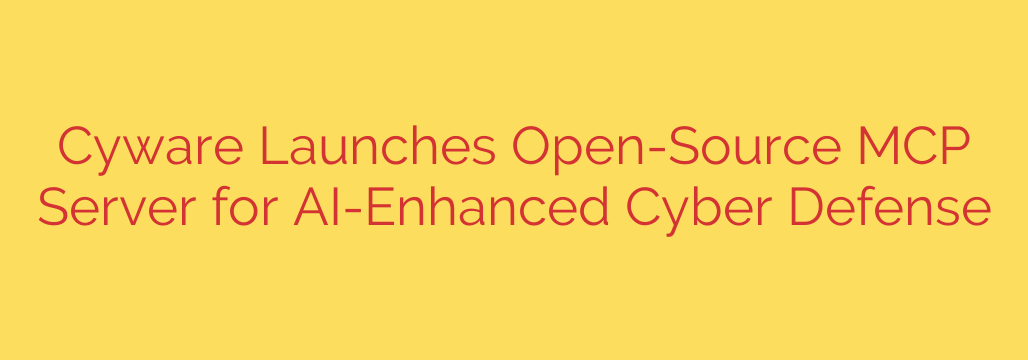
Unlocking AI for Cyber Defense: A New Open-Source Tool Bridges the Gap Between LLMs and Security Operations
In today’s complex threat landscape, security teams are often overwhelmed. They juggle a dozen different tools, from SIEM and SOAR platforms to EDR solutions, each operating in its own silo. This fragmentation leads to alert fatigue, manual and repetitive analysis, and a critical delay in responding to real threats. The promise of Artificial Intelligence, particularly Large Language Models (LLMs), to alleviate this burden has been clear, but a crucial piece has been missing: a bridge to connect these powerful AI models with the existing security infrastructure.
A groundbreaking open-source server has been released to solve this exact problem. It is designed to act as a central nervous system for security operations, enabling seamless communication between various security tools and advanced AI models. This new development marks a significant step forward in making AI-driven cyber defense accessible, customizable, and more effective for organizations of all sizes.
The Challenge: Siloed Tools and Manual Processes
Security Operations Centers (SOCs) are the front lines of cyber defense, but they often fight with one hand tied behind their back. Key challenges include:
- Data Silos: Threat intelligence, endpoint data, and network logs are stored in different systems that don’t communicate well.
- Manual Correlation: Analysts spend countless hours manually correlating alerts and piecing together the narrative of an attack.
- Slow Response: The time it takes to analyze a threat and create a defensive action plan can be too long, giving adversaries a critical window to cause damage.
While LLMs like those powering ChatGPT have shown incredible potential for summarizing text, generating code, and explaining complex concepts, integrating them directly into a SOC’s workflow has been a major technical hurdle.
A New Hub for AI-Powered Security
This new open-source server introduces a standardized communication protocol—the MITRE Caldera™ for Pluggable Operations (MCP)—to act as a universal translator. It allows disparate security platforms to “talk” to each other and, more importantly, to query AI models for sophisticated analysis.
Imagine your SIEM detecting a suspicious pattern. Instead of an analyst manually investigating it, the system can now automatically:
- Package the alert data.
- Send it through the MCP server to an LLM.
- Ask the AI to analyze the threat, explain its potential impact, and even suggest a response.
This entire process happens in seconds, transforming a manual, multi-step investigation into an automated, intelligent workflow.
Key Benefits for Modern Security Teams
The introduction of this open-source technology provides tangible benefits that directly address the pain points of modern security teams.
- Breaks Down Data Silos: By creating a common language for security tools, the server enables a unified view of an organization’s security posture. Threat intelligence can be instantly correlated with real-time alerts, providing a richer context for every investigation.
- Automates Complex Threat Analysis: Tedious tasks that once consumed hours of an analyst’s time can now be offloaded to AI. This includes summarizing complex threat reports, translating obscure log files into plain English, and identifying relationships between different security events.
- Enhances Adversary Emulation: Red and purple teams can now leverage AI to streamline their testing. They can use the server to query an LLM to automatically generate adversary emulation plans based on specific threat actor profiles (like APT28 or Lazarus Group). These plans can then be executed using frameworks like MITRE Caldera™ to proactively test and validate defenses.
- Speeds Up Defensive Playbook Creation: When a new threat is identified, time is of the essence. This tool allows blue teams to use AI to rapidly generate defensive rules and signatures (such as Sigma or YARA-L) based on the threat’s characteristics, significantly reducing the time to protection.
- The Power of Open-Source: Because the server is open-source, it is free to use, highly customizable, and benefits from community-driven development. Security teams can adapt it to their specific environment and contribute back to the project, fostering a collaborative approach to cyber defense.
Actionable Tips for Integrating AI into Your Security Strategy
Leveraging this new capability requires a thoughtful approach. Here are a few security tips for getting started:
- Start with a Clear Use Case: Don’t try to boil the ocean. Identify a specific, high-value task to automate first, such as triaging phishing alerts or analyzing malware reports.
- Ensure Data Privacy: When sending data to external AI models, be mindful of privacy and confidentiality. Use internal, privately-hosted LLMs for sensitive information or ensure your data is properly anonymized.
- Validate AI-Generated Outputs: Treat AI as a highly-skilled assistant, not an infallible oracle. Always have a human-in-the-loop process to review and validate AI-generated analysis and response plans before they are implemented.
- Foster Collaboration: This technology is a powerful catalyst for breaking down silos between red, blue, and purple teams. Use it to create a shared platform for testing, defending, and learning.
The launch of this open-source server represents a pivotal moment for the cybersecurity industry. By democratizing access to AI-enhanced defense, it empowers security teams to move from a reactive to a proactive posture, finally giving them the leverage they need to stay ahead of sophisticated adversaries.
Source: https://www.helpnetsecurity.com/2025/08/06/cyware-unveils-open-source-mcp-server-to-power-ai-driven-cyber-defense/








